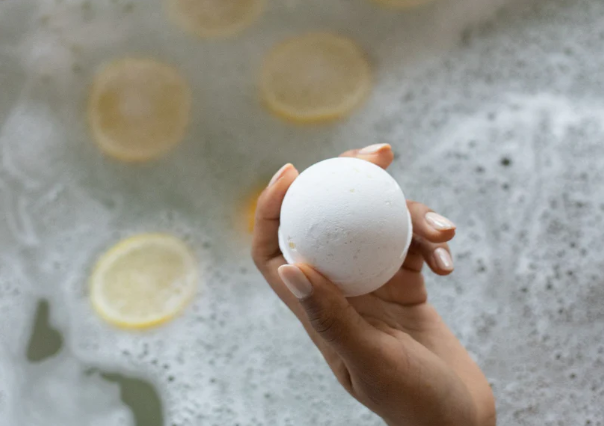What Is A Bath Bomb?
A bath bomb or bath fizzy is a consumer product used during bathing. It was invented and patented in 1989 by Mo Constantine, co-founder of Lush Cosmetics. A bath bomb is a compacted mixture of wet and dry ingredients molded into any of several shapes and then dried. Bath water effervesces at the surface of a bath bomb immersed within it, with attendant dispersion of such ingredients as essential oil, moisturizer, scent, or colorant.

Ingredients Inside Bath Bombs
There are many varieties of bath bombs, but they all have some basic ingredients that make them fizzy and last during bathtime. Let’s discuss the main ingredients in bath bombs.
- Epsom Salt (also known as magnesium sulfate) is probably something you’ve heard of – it’s composed of sulfur, magnesium, and oxygen.
- Uses: For hundreds of years, it’s been used to treat insomnia, fatigue, muscle pain, and fibromyalgia, but it’s important to note that these benefits haven’t been really researched as a treatment.
- While some people do drink it (not recommended), most people use epsom salt soaks as a way to manage stiffness, muscle pain, and swelling
- Sodium bicarbonate is a combination of citric acid and baking soda. When citric acid and baking soda are introduced into the bath water, they give the bath bombs a fizzy consistency.
- Uses: When these ingredients hit the water (through amazing chemical reactions), carbon dioxide gas is released, which forms bubbles in the water, eventually giving you that delightful fizzy feeling.
- Cornstarch is another ingredient that you’ll likely see listed on the label of your bath bombs, and it serves a very important purpose.
- Uses: to slow down the chemical reactions so that the fizz (carbon dioxide – a gas) lasts longer.
How Does Bath Bomb Work?
The “bomb” aspect of a bath bomb is the fizziness. But what’s going on in those spheres that make them so fizzy? Two of the key ingredients to a bath bomb are citric acid and sodium bicarbonate. You might also know sodium bicarbonate by its more common name, baking soda. These two ingredients are what cause the impressive and delightful fizz when the bath bomb enters the water.
When sodium bicarbonate (NaHCO3) comes in contact with water, the sodium (Na) molecules break off from the bicarbonate (HCO3). At the same time, the citric acid is dissolving, with a single hydrogen ion (H+) separating from the rest of the molecule. Another reaction happens when the released hydrogen ion from the citric acid encounters the bicarbonate from the baking soda! This time, carbon dioxide (CO2) gas is released as one of the end products. The carbon dioxide forms bubbles in the soap and bath water and rushes to the surface with a delightful fizz.
Are Bath Bombs Bad For Your Septic Tank?

We hate to be the bearers of bad news, but septic systems and bath bombs usually don’t mix. Here are the reasons why bath bombs are bad for your septic tank:
- Oils and fats: Shea butter, cocoa butter, coconut oil, and Essential Oils are common ingredients in bath bombs. Those ingredients (along with perfumes and other fragrances) combine to form a layer of fat that causes blockages in the leach field. These blockages cause a variety of septic problems and are expensive to fix.
- Decorative solids: Many bath bombs contain decorative flowers and glitter that look nice in the water. While they’re pretty to look at, they cause some not-so-pretty issues once the bathwater goes down the drain. Again, these solids float to the top of your septic tank and can clog up the pipes in your leach field.
- Salts: Epsom salt or sea salt are other common ingredients in bath bombs. They’re beneficial in soothing sore muscles in joints but often don’t dissolve completely. When salts don’t dissolve, they can cause clogs in your home’s plumbing or the tank itself. They can even harm the bacteria in your septic system in high concentrations.
Using Bath Bombs Safely
For septic system owners, moderation is key when using bath bombs. Opt for simple formulations with easily biodegradable ingredients, avoiding those with excessive oils, kinds of butter, or non-dissolving components. Ensure the bathtub is well-drained and flush extra water through the pipes afterward.
Installing septic-safe drain catchers and filters can also help prevent solid bath bomb particles from entering the septic system. Consider spacing out bath bomb usage to allow the system to process residues effectively.





